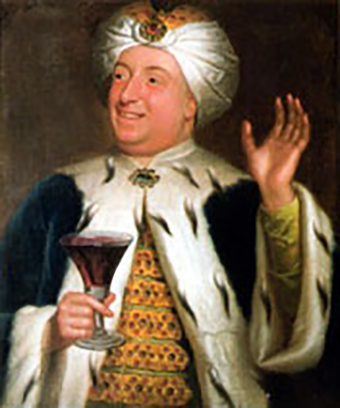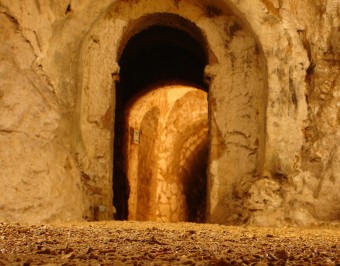The Not-So-Holy Order of the Friars of St. Francis of Wycombe
 Established in West Wycombe by Sir Francis Dashwood in 1749, the Brotherhood of St. Francis of Wycombe was anything but saintly. Devoted to wicked fun and debauchery, for the next two decades, many notable individuals in England counted themselves members, such as the 4th Earl of Sandwich, John Montagu, Baron George Dodington, member of Parliament Thomas Potter, and, while not a full member, distinguished guest Ben Franklin, who was a friend of Dashwood’s and is known to have attended meetings when in town. In these meetings, the group drank, ate and fornicated at will, trying their hardest to live up to the future moniker of “Hellfire Club”.
Established in West Wycombe by Sir Francis Dashwood in 1749, the Brotherhood of St. Francis of Wycombe was anything but saintly. Devoted to wicked fun and debauchery, for the next two decades, many notable individuals in England counted themselves members, such as the 4th Earl of Sandwich, John Montagu, Baron George Dodington, member of Parliament Thomas Potter, and, while not a full member, distinguished guest Ben Franklin, who was a friend of Dashwood’s and is known to have attended meetings when in town. In these meetings, the group drank, ate and fornicated at will, trying their hardest to live up to the future moniker of “Hellfire Club”.
Although the Order first met in London at the George and Vulture pub, beginning in 1750, Dashwood leased Medmenham Abbey, a rundown former Cistercian abbey, which was close to his home. Rebuilding it and excavating what are now known as the “Hellfire Caves” beneath it (a network of man-made caves extending over 1,500 feet into the hillside), Dashwood had the inscription Fay ce que voudras (“Do what thou wilt”) placed over the entrance, and the members complied.
Mocking certain religious groups, during the get-togethers, the friars referred to each other as “brothers,” addressed the leader in a given year as “Abbot” and called the prostitutes in attendance “nuns.” In those caves, they also play-acted at pagan rituals, drank copiously of wine and port, gambled, laughed and joked around and, of course, enjoyed the company of women. In the 1779 work, Nocturnal Revels, it describes the general activities of the meetings:
They however always meet in one general sett at meals, when, for the improvement of mirth, pleasantry, and gaiety, every member is allowed to introduce a Lady of cheerful lively disposition, to improve the general hilarity. Male visitors are also permitted, under certain restrictions, their greatest recommendation being their merit wit and humour. There is no constraint with regard to the circulation of the glass, after some particular toasts have been given: The Ladies, in the intervals of their repasts, may make select parties among themselves, or entertain one another, or alone with reading, musick, tambour-work, etc. The salt of these festivities is generally purely attic, but no indelicacy or indecency is allowed to be intruded without a severe penalty; and a jeu de mots must not border too much upon a loose double entendre to be received with applause.
 Although their mock-pagan activities ultimately led to rumors of satanic rituals at these meetings, there is no real evidence to support this. In fact, the Order’s founder, Dashwood, even devoted himself to rebuilding, at no small expense, a local church at this time, the nearby St. Lawrence. For the members, the whole charade was simply a bit of farcical fun, rather than its constituents actually being devoted to pagan ideals. Or as member MP John Wilkes put it- “a set of worthy, jolly fellows, happy disciples of Venus and Bacchus, got occasionally together to celebrate woman in wine and to give more zest to the festive meeting, they plucked every luxurious idea from the ancients and enriched their own modern pleasures with the tradition of classic luxury.”
Although their mock-pagan activities ultimately led to rumors of satanic rituals at these meetings, there is no real evidence to support this. In fact, the Order’s founder, Dashwood, even devoted himself to rebuilding, at no small expense, a local church at this time, the nearby St. Lawrence. For the members, the whole charade was simply a bit of farcical fun, rather than its constituents actually being devoted to pagan ideals. Or as member MP John Wilkes put it- “a set of worthy, jolly fellows, happy disciples of Venus and Bacchus, got occasionally together to celebrate woman in wine and to give more zest to the festive meeting, they plucked every luxurious idea from the ancients and enriched their own modern pleasures with the tradition of classic luxury.”
All good things must come to an end, and the Friars’ fun began to wind down around 1762 when Dashwood was appointed to be the Chancellor of the Exchequer- a job he was terrible at. For instance, a tax he imposed on cider, the Cider Bill of 1763, so incensed the populace that they nearly rioted; he resigned shortly thereafter. By this time, he had also become a member of the House of Lords as Baron Le Despencer.
In addition to Dashwood becoming respectable, another key member of the Order, the aforementioned member of Parliament John Wilkes, was forced into exile after he was caught printing Essay on Woman, a parody of Essay on Man, by Alexander Pope. The former’s blasphemous, libelous and debauched content was considered illegal at the time, landing Wilkes in more than a little hot water. And if you’re wondering, it’s generally thought today that fellow Order member and MP Thomas Potter, son of the Archbishop of Canterbury, was the actual author of the work, not Wilkes.
Together with many other brothers having left the area or died, this Hellfire Club became defunct by 1766 and the caves stripped of their former scandalous adornments and other evidence of the noteworthy group’s former meetings there.
If you liked this article, you might also enjoy our new popular podcast, The BrainFood Show (iTunes, Spotify, Google Play Music, Feed), as well as:
- How Voltaire Made a Fortune Rigging the Lottery
- The Large Number of Human Remains Found In Ben Franklin’s Basement
- How Did the Practice of Women Jumping Out of Giant Cakes Start?
- Babe Ruth – The Ladies’ Man
- The First Flapper: Zelda Fitzgerald
Bonus Facts:
- The Brotherhood was not the first Hellfire Club, and that one was founded in London in 1718 by Philip, Duke of Wharton. Its membership was secret although many believe Wharton’s closest friends, including his cousin the Earl of Hillsborough, the Earl of Lichfield and Sir Ed. O’Brien, were a part of it. The first Hellfire Club also began the practice of ridiculing religion as a practice of the meetings, and according to some reports, the members dressed-up as characters from the Bible for their get-togethers. Unusually, women and men were admitted to club membership as equals, and meetings were held in a number of places, including The Greyhound Tavern and at members’ houses. Having too much fun, apparently, after Wharton’s political rivals convinced him to, King George I enacted a law against “horrid impieties,” in 1721, which pretty much ended this first Hellfire club, losing Wharton his seat in Parliament in the process. Undeterred, the next year Wharton became the Freemason Grand Master of England.
- Apparently a popular idea, other Hellfire clubs have been established through the years and these include the Phoenix Society, founded in 1781 by Dashwood’s nephew Joseph Alderson in honor of Dashwood who died that year; this club has continued through the present day at Brasenose College, Oxford. Other colleges and universities also sport Hellfire Clubs, including Trinity College in Dublin and Maynooth University.
- Dashwood’s friend, the famous painter William Hogarth who is perhaps best known for The Rake’s Progress, painted a parody of Dashwood titled Sir Francis Dashwood at his Devotions. In the portrait, Dashwood is on his knees in the posture often used to portray St. Francis at prayer, but instead of a Bible, Dashwood peruses an erotic novel, and instead of contemplating the mystery of the Trinity, Dashwood contemplates the image of a naked woman.
- Dashwood lived a colorful life, spending most of his young adulthood travelling Europe after ascending to his Baronetcy at the age of 15. At one point he impersonated the King of Sweden in order to seduce the Tsarina; on another occasion, he was expelled from the Papal states.
| Share the Knowledge! |
|





This page should be deleted, because it is worse than worthless. It is of no positive value to anyone to know about these wretched matters. In fact, this page is a “tool” of satan for corrupting innocent young readers who come here. [I am not claiming that the author is a satanist, possessed, etc.. Instead, I would charitably assume that she was woefully ignorant of what was the right or wrong thing to do in this situation — the right thing being NOT to write about this kind of garbage. I hope, for the sake of his soul, that the owner of the site was equally ignorant and would begin to act in accord with right reason today.]
[Piss off]
And it’s “accordance”, you self-righteous moron.
I opened the page was just skimmed the article. I saw Gecik’s comment and became more interested. I went back to read it. Then I gave it to my kids to read.
I must respectfully disagree with J. F. Gecik. This article is rollicking good fun and interesting, as most history is. I also must point out that this article in no way influences me to act in a wretched manner. I really don’t have the desire to go out and participate in debauchery or anti-religious blasphemy. My values are still intact and Satan was unable to grab a firmer hold on my soul. If anything, I wish the article was longer. I am kind of curious if the Hellfire Clubs that exist today are as bad as the ones in the 18th century.